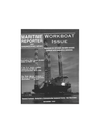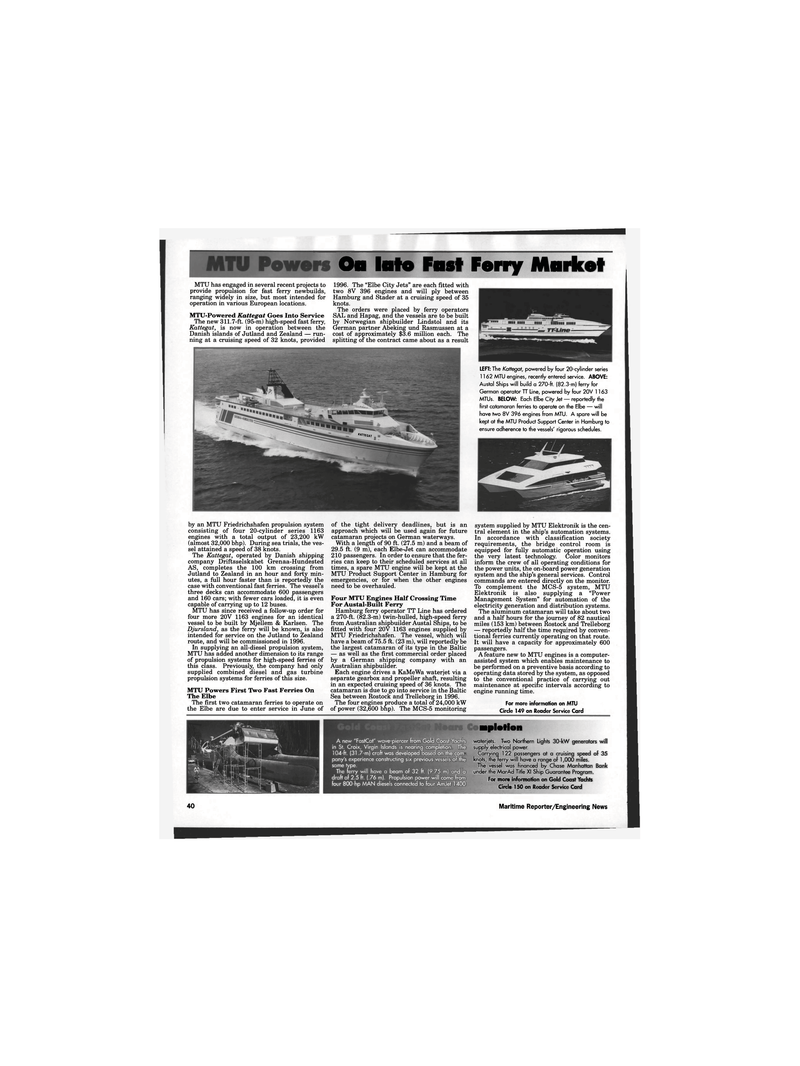
Page 38: of Maritime Reporter Magazine (November 1995)
Read this page in Pdf, Flash or Html5 edition of November 1995 Maritime Reporter Magazine
On Into Fnst Ferry Mnrket
MTU has engaged in several recent projects to provide propulsion for fast ferry newbuilds, ranging widely in size, but most intended for operation in various European locations.
MTU-Powered Kattegat Goes Into Service
The new 311.7-ft. (95-m) high-speed fast ferry,
Kattegat, is now in operation between the
Danish islands of Jutland and Zealand — run- ning at a cruising speed of 32 knots, provided 1996. The "Elbe City Jets" are each fitted with two 8V 396 engines and will ply between
Hamburg and Stader at a cruising speed of 35 knots.
The orders were placed by ferry operators
SAL and Hapag, and the vessels are to be built by Norwegian shipbuilder Lindstol and its
German partner Abeking und Rasmussen at a cost of approximately $3.6 million each. The splitting of the contract came about as a result
LEFT: The Kattegat, powered by four 20-cylinder series 1162 MTU engines, recently entered service. ABOVE:
Austal Ships will build a 270-ft. (82.3-m) ferry for
German operator TT Line, powered by four 20V 1163
MTUs. BELOW: Each Elbe City Jet — reportedly the first catamaran ferries to operate on the Elbe — will have two 8V 396 engines from MTU. A spare will be kept at the MTU Product Support Center in Hamburg to ensure adherence to the vessels' rigorous schedules. by an MTU Friedrichshafen propulsion system consisting of four 20-cylinder series 1163 engines with a total output of 23,200 kW (almost 32,000 bhp). During sea trials, the ves- sel attained a speed of 38 knots.
The Kattegat, operated by Danish shipping company Driftsselskabet Grenaa-Hundested
AS, completes the 100 km crossing from
Jutland to Zealand in an hour and forty min- utes, a full hour faster than is reportedly the case with conventional fast ferries. The vessel's three decks can accommodate 600 passengers and 160 cars; with fewer cars loaded, it is even capable of carrying up to 12 buses.
MTU has since received a follow-up order for four more 20V 1163 engines for an identical vessel to be built by Mjellem & Karlsen. The
Djursland, as the ferry will be known, is also intended for service on the Jutland to Zealand route, and will be commissioned in 1996.
In supplying an all-diesel propulsion system,
MTU has added another dimension to its range of propulsion systems for high-speed ferries of this class. Previously, the company had only supplied combined diesel and gas turbine propulsion systems for ferries of this size.
MTU Powers First Two Fast Ferries On
The Elbe
The first two catamaran ferries to operate on the Elbe are due to enter service in June of of the tight delivery deadlines, but is an approach which will be used again for future catamaran projects on German waterways.
With a length of 90 ft. (27.5 m) and a beam of 29.5 ft. (9 m), each Elbe-Jet can accommodate 210 passengers. In order to ensure that the fer- ries can keep to their scheduled services at all times, a spare MTU engine will be kept at the
MTU Product Support Center in Hamburg for emergencies, or for when the other engines need to be overhauled.
Four MTU Engines Half Crossing Time
For Austal-Built Ferry
Hamburg ferry operator TT Line has ordered a 270-ft. (82.3-m) twin-hulled, high-speed ferry from Australian shipbuilder Austal Ships, to be fitted with four 20V 1163 engines supplied by
MTU Friedrichshafen. The vessel, which will have a beam of 75.5 ft. (23 m), will reportedly be the largest catamaran of its type in the Baltic — as well as the first commercial order placed by a German shipping company with an
Australian shipbuilder.
Each engine drives a KaMeWa waterjet via a separate gearbox and propeller shaft, resulting in an expected cruising speed of 36 knots. The catamaran is due to go into service in the Baltic
Sea between Rostock and TYelleborg in 1996.
The four engines produce a total of 24,000 kW of power (32,600 bhp). The MCS-5 monitoring system supplied by MTU Elektronik is the cen- tral element in the ship's automation systems.
In accordance with classification society requirements, the bridge control room is equipped for fully automatic operation using the very latest technology. Color monitors inform the crew of all operating conditions for the power units, the on-board power generation system and the ship's general services. Control commands are entered directly on the monitor.
To complement the MCS-5 system, MTU
Elektronik is also supplying a "Power
Management System" for automation of the electricity generation and distribution systems.
The aluminum catamaran will take about two and a half hours for the journey of 82 nautical miles (153 km) between Rostock and Trelleborg — reportedly half the time required by conven- tional ferries currently operating on that route.
It will have a capacity for approximately 600 passengers.
A feature new to MTU engines is a computer- assisted system which enables maintenance to be performed on a preventive basis according to operating data stored by the system, as opposed to the conventional practice of carrying out maintenance at specific intervals according to engine running time.
For more information on MTU
Circle 149 on Reader Service Card mplefion
A new "FastCat" wave-piercer from Gold Coast Yachts in St. Croix, Virgin Islands is nearing completion. The 104-ft. (31.7-m) craft was developed based on the com- pany's experience constructing six previous vessels of the same type.
The ferry will have a beam of 32 ft. (9.75 m) and a draft of 2.5 ft. (.76 m). Propulsion power will come from four 800-hp MAN diesels connected to four AmJet 1400 waterjets. Two Northern Lights 30-kW generators will supply electrical power.
Carrying 122 passengers at a cruising speed of 35 knots, the ferry will have a range of 1,000 miles.
The vessel was financed by Chase Manhattan Bank under the MarAd Title XI Ship Guarantee Program.
For more information on Gold Coast Yachts
Circle 150 on Reader Service Card "rrecAr 40 Maritime Reporter/Engineering News

 37
37

 39
39
